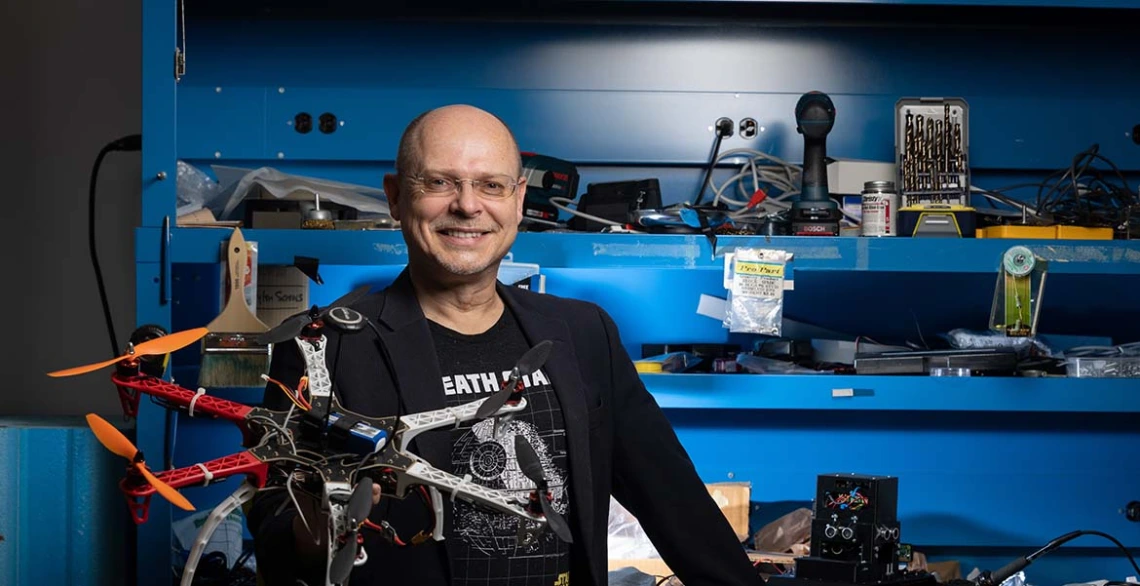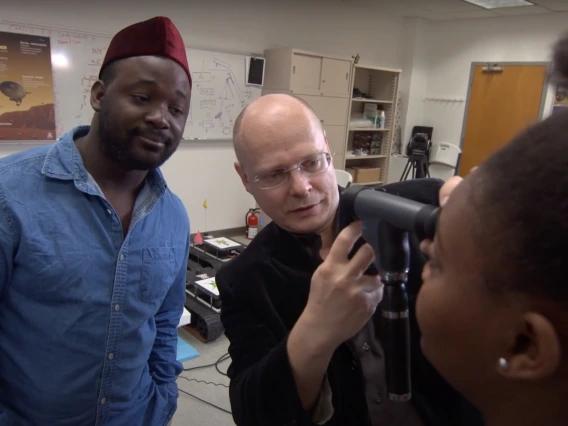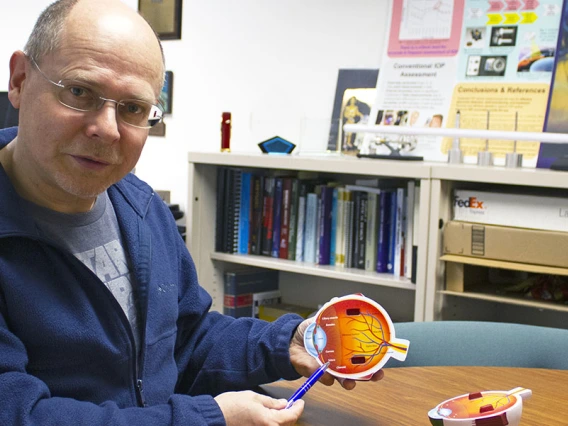From Microelectronics to Mars
The Edward & Maria Keonjian Endowed Chair Supports Discoveries Big and Small.

Wolfgang Fink. Chris Richards photo
Wolfgang Fink is the inaugural Edward & Maria Keonjian Endowed Chair, with joint appointments at the in the departments of electrical and computer engineering, biomedical engineering, systems and industrial engineering, aerospace and mechanical engineering, and ophthalmology and vision science. Fink is the founder and director of both the Visual and Autonomous Exploration Systems Research Laboratory and the Arizona Center for Informatics and Telehealth in Medicine.
Which of Your Research Projects Have Been Supported By the Edward & Maria Keonjian Endowment?
I would almost have to ask the reverse question: Which research has not been supported? That would be much easier to answer. The Edward & Maria Keonjian endowment has been a major support in the running of the Visual and Autonomous Exploration Systems Research Laboratory. In terms of supplies, devices and machinery, it has significantly supported both the biomedical side, with its vision-related research, and the autonomous-systems side, which involves the exploration of other planets.
What Are Some Specific Examples of Research the Keonjian Endowment Has Supported?
Most recently, largely thanks to the Keonjian endowment, we got a paper accepted regarding subsurface exploration on other planets. Prior to that, the VISTA project, in which several students and I built a navigational aid for the visually impaired, was greatly supported by the Keonjian endowment. Part of the gift of that funding is that it’s discretionary, so in the case of the VISTA project, when three undergraduate students approached me after a talk because they wanted to participate in the kind of research I discussed, we were able to develop a research project that wound up spanning two semesters, generating course credit for the students and resulting in compound successes: a functional protype that is useful to the key stakeholders, a journal article, a conference presentation and a local TV and news story.
What’s New? What Is Your Current Research and Where Is It Headed?
I’m working in the areas of autonomous decisionmaking, which includes autonomous vehicles for space applications as well as for applications in hazardous environments. On the biomedical side, my research is largely focused on vision and eyes. In recent years, we have also been working in tandem with NASA on how to support astronauts in future space habitats. The idea is to make sure the astronauts’ health is being monitored in the same way as the machinery, in part by looking at biometric data that tell us not only about the health of the astronaut but also about the health of the habitat itself.
I’m also continuing to work with a former PhD student on soft robotics for subsurface exploration of water bodies, such as extraterrestrial oceans. That’s because in such subsurface environments, as well as in caves, you have the potential to find life and favorable conditions for human habitation.
Why Are Endowments Important for Excellence In Research?
The key importance of endowments is you’re not constrained. You can explore new ideas right now. Grants favor mainstream research and are so competitive that I have approximately a 10-15% chance of receiving funding when I apply for one. Even if this time-intensive process yields funding, I still have to wait six months before I receive the first installment.
The beauty of philanthropic funding is that it supports the pursuit of truly novel ideas that are beyond the purview of funding agencies, and it offers opportunities that you can’t typically access with grant or federal funding, like the opportunity to attend a conference in a new field of interest.
Philanthropic funding can help with obtaining equipment, establishing programs and involving students in a project, all in service of making proofs of concept or breaking ground in new areas.
You can be truly ahead of the curve with this kind of support.
Meet Maria Keonjian
My husband, Edward, and I met when he was 73. I loved him very much. He was an exceptional person and well rounded, too. He was a fantastic amateur photographer, and he loved traveling and meeting people in addition to engineering. He was a very interesting person to talk to. However, we couldn’t have any children, so I wanted something to stay behind from both of us; I wanted my husband’s name to be remembered. For that reason, endowing a chair at the university was especially meaningful to us. I met Dr. Fink on what would have been my husband’s 100th birthday, and I’ve known him 13 years now. I’m especially impressed with Dr. Fink’s work in the realm of vision. After I had COVID-19, they found I had macular degeneration, and Dr. Fink is working on that, so I’m very proud that he’s helping to eradicate this terrible disease. I could not have asked for a better professor to be the first holder of the endowed chair named for my husband and me. Dr. Fink is totally dedicated to his research, and he is really carrying on the legacy that started with my husband — who was one of the fathers of the microchip through his work with microelectronics. I’ve also never known of someone having so many awards, but Dr. Fink deserves recognition for his tremendous work. I think my husband would be pleased to see Dr. Fink’s progress and many achievements in engineering.



